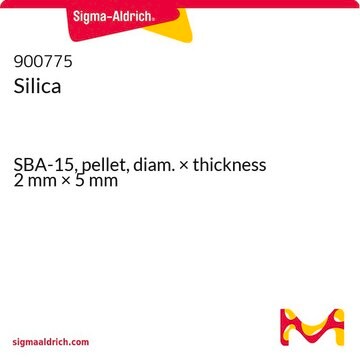643645
Silica, mesostructured
MCM-41 type (hexagonal)
Synonym(s):
Silica, Silicon dioxide
About This Item
Recommended Products
Quality Level
form
powder
surface area
~1000 m2/g , BET
unit cell size
4.5-4.8 nm
pore size
0.98 cm3/g pore volume
2.1-2.7 nm pore size
bp
2230 °C (lit.)
mp
>1600 °C (lit.)
bulk density
0.34 g/mL
application(s)
battery manufacturing
SMILES string
O=[Si]=O
InChI
1S/O2Si/c1-3-2
InChI key
VYPSYNLAJGMNEJ-UHFFFAOYSA-N
Looking for similar products? Visit Product Comparison Guide
Related Categories
General description
Application
Storage Class Code
13 - Non Combustible Solids
WGK
nwg
Flash Point(F)
Not applicable
Flash Point(C)
Not applicable
Choose from one of the most recent versions:
Already Own This Product?
Find documentation for the products that you have recently purchased in the Document Library.
Customers Also Viewed
Articles
Mesoporous Materials include a range of high surface area porous silicates with applications in gas adsorption, drug delivery, diagnostics and catalysis.
Mesoporous materials are formed by a self-assembly process from combined solutions of sol-gel precursors (e.g., metal alkoxides) and structure-directing amphiphiles, usually block-copolymers or surfactants.
A key challenge for nanomaterial safety assessment is the ability to handle the large number of newly engineered nanomaterials (ENMs), including developing cost-effective methods that can be used for hazard screening.
Silica is a very popular inorganic nanomaterial used in a wide range of applications including fillers for rubber, catalyst supports, separation media, carriers in food and agriculture, and abrasive/anticaking agents in cosmetics. It is also widely believed to be an important material for biomedical applications for following reasons.
Global Trade Item Number
| SKU | GTIN |
|---|---|
| 643645-25G | 4061835571765 |
| 643645-5G | 4061835512034 |
Our team of scientists has experience in all areas of research including Life Science, Material Science, Chemical Synthesis, Chromatography, Analytical and many others.
Contact Technical Service




